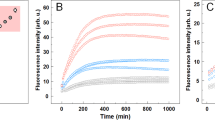Abstract
A growing body of evidence supports the nucleation hypothesis of fibrillar amyloid formation. In this article, it is hypothesized that the fibrils formed with human Aβ, rodent Aβ, and a mixture of the two peptides may form nearly identical physical structures with clearly different biological activities. Data is reported supporting the concept that a specific “strain” of nucleation seed could impart a new structure on a growing amyloid fibril, thereby changing its biological activity. The data that the biological activities of specific prion strains have a basis in strain-specific structure have been supported experimentally.
Similar content being viewed by others
References
Behl C., Davis J. B., Lesley R., and Schubert D. (1994) Hydrogen peroxide mediates amyloid β protein toxicity.Cell 77, 817–827.
Besson R. A., Kocisko D. A., Raymond G. J., Nandan S., Lansbury P. T., and Caughey B. (1995) Non-genetic propagation of strain-specific properties of scrapie prion protein.Nature 375, 698–700.
Come J. H., Fraser P. E., and Lansbury P. T. (1993) A kinetic model for amyloid formation in the prion diseases: importance of seeding.Proc. Natl. Acad. Sci. USA 90, 5959–5963.
Dickson D., Salles F., Vitek M. P., and Lee S. H. (1995).Soc. Neurosci. Abs. 21, 108.5.
Eaton W. A. and Hofrichter J. (1991) Sickle cell hemoglobin polymerization.Adv. Protein Chem. 40, 63–279.
Jarrett J. T., Berger E. P., and Landsbury P. T., Jr. (1993) The carboxy terminus of the β amyloid protein is critical for the seeding of amyloid formation: implications for the pathogenesis of Alzheimer's disease.Biochemistry 32, 4693–4697.
Makita Z., Vlassara H., Cerami A., and Bucala R. (1992) Immunochemical detection of advanced glycosylation end products in vivo.J. Biol. Chem. 32, 4693–4697.
Makita Z., Vlassara H., Cerami A., and Bucala R. (1992) Immunochemical detection of advanced glycosylation end products in vivo.J. Biol. Chem. 267, 5133–5238.
Shearman M. S., Ragan C., and Iverson L. I. (1994) Inhibition of PC12 cell redox activity is a specific, early indicator of the mechanism of β-amyloid-mediated cell death.Proc. Natl. Acad. Sci. USA 91, 1470–1474.
Smith M. A., Taneda S., Richey P. L., Miyata S., Yan S., Stern D., Sayre L., Monnier V., and Perry G. (1994) Advanced maillard reaction end products are associated with Alzheimer disease pathology.Proc. Natl. Acad. Sci. USA 91, 5710–5714.
Vitek M. P., Bhattacharya K., Glendening J. M., Stopa E., Vlassara H., Bucala R., Manogue K., and Cerami A. (1994) Advanced glycosylation endproducts contribute to amyloidosis in Alzheimer's Disease.Proc. Natl. Acad. Sci. USA 91, 4766–4770.
Author information
Authors and Affiliations
Rights and permissions
About this article
Cite this article
Vitek, M.P. Radical changes in β-amyloid form and function. Molecular and Chemical Neuropathology 28, 49–55 (1996). https://doi.org/10.1007/BF02815204
Received:
Accepted:
Published:
Issue Date:
DOI: https://doi.org/10.1007/BF02815204




